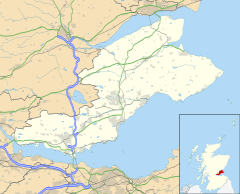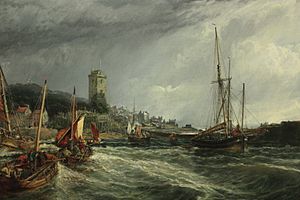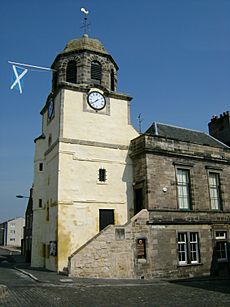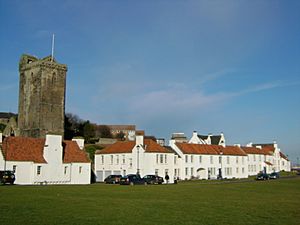Dysart, Fife facts for kids
Quick facts for kids Dysart
|
|
|---|---|
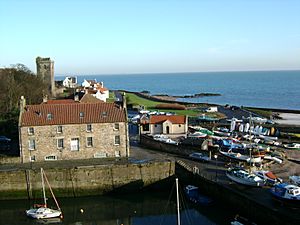 A view of Dysart harbour with Harbourmaster's House and the remains of St Serf's Church being visible to the north-east |
|
| OS grid reference | NT305935 |
| Council area | |
| Lieutenancy area | |
| Country | Scotland |
| Sovereign state | United Kingdom |
| Post town | KIRKCALDY |
| Postcode district | KY1 |
| Dialling code | 01592 |
| Police | Fife |
| Fire | Fife |
| Ambulance | Scottish |
| EU Parliament | Scotland |
| UK Parliament |
|
| Scottish Parliament |
|
Dysart is a town on the south-east coast of Fife, Scotland. It sits between Kirkcaldy and West Wemyss. Dysart was once a "royal burgh," which means it was a special town with its own rights given by the king or queen. The St Clair or Sinclair family owned the land here for a long time. They helped Dysart become a burgh (a town with special trading rights) in the late 1400s.
The first mention of Dysart was in the early 1200s. Back then, it helped solve problems between the church and landowners. By the mid-1400s, Dysart started trading with countries like the Low Countries (modern-day Netherlands and Belgium). They exported important goods like salt and coal. Later, in the 1500s and 1600s, trade grew even more, reaching the Baltic Countries. Because of this busy trade, Dysart earned two cool nicknames: "Salt Burgh" and "Little Holland."
Sadly, the town's harbour became less important when a big coal mine called Lady Blanche Pit closed. This led to Dysart joining the larger town of Kirkcaldy in 1930. In the 1950s and 1960s, many old buildings were knocked down to build new homes. But people in Dysart wanted to save their history. So, parts of the old town, especially the beautiful 16th and 18th-century houses on Pan Ha' near the harbour, were saved and protected.
Contents
The Story of Dysart
The name Dysart comes from a Scottish Gaelic word, dìseart. This means "a quiet place for religious people" or "a religious retreat." It's linked to Saint Serf, who was a hermit (someone who lives alone for religious reasons) in a cave nearby in the 700s.
We don't know much about Dysart's early history before the 1500s. The oldest record of the town is from 1220. It's about a church decision between Dysart Kirk and Dunfermline Abbey. Another record from 1245 talks about the church being blessed again. Like many towns in Scotland, Dysart's first job was to help the church and landowners with local issues and property matters.
Dysart's Busy Harbour
Dysart's first port might have been used as early as 1450. This helped the town export coal and salt to its trading partners, the Low Countries. Later, a man-made harbour was built. However, it could only be used when the tide was low and didn't have much space. In the mid-1600s, a part of the harbour called the "east haven" was damaged, stopping trade for a while.
But the harbour was rebuilt in a big way between 1829 and 1831. Robert Stephenson, a famous engineer, helped with this project. They added an inner basin and made the east pier longer and stronger.
Trade and Nicknames
The 1500s and 1600s were tough for Dysart. Many people, especially sailors, died in wars and during Oliver Cromwell's occupation from 1651 to 1656. Despite this, the salt trade boomed between Dysart and its partners, the Netherlands and the Baltic Countries. This was especially true between 1570 and 1630.
This is how Dysart got its nicknames:
- Salt Burgh: Because the town's salt industry was so important for preserving fish to be exported.
- Little Holland: Because Dutch traders and shipowners visited Dysart so often, they influenced the style of buildings in the town.
The first coal mine in Dysart, called Lady Blanche, opened in the late 1500s. Two more mines, Frances and Randolph, opened by the mid-1600s. Coal soon became more important than salt. The harbour also became busy again, importing wine and spirits that were then sent to other harbours like Leith and Dundee.
However, Dysart's good times started to fade in the late 1600s. By 1715, the harbour was in bad shape. There were also food shortages in the 1720s because so much food was being exported. This led to big protests in the town, with thousands of people on the streets.
End of an Era
In the 1920s, the owners of the harbour, the Earl of Rossyln's Coal Company, wanted to make the harbour deeper for bigger ships. The town council agreed, but the coal company refused to pay for the expensive work. This left the council in financial trouble. Many ships started going to other harbours like Buckhaven and Methil instead, where they could get in and out faster.
When the Lady Blanche Pit coal mine closed in 1929 because it wasn't making money, it was the end of Dysart's coal trade from the harbour. Without money coming in from the harbour, Dysart had to join Kirkcaldy in 1930.
Today, Dysart is like a northern part of Kirkcaldy. It's also a "conservation area," which means its historic buildings and character are protected. Important places include the Dutch-style houses on Pan Ha', the tall St Serf's Church Tower, Dysart Tolbooth, and the Francis Colliery gearhead (a mining structure). A big project costing £11 million has been working to fix up historic buildings and the harbour, and to build new homes.
Dysart's Churches
The old church in Dysart, before the Scottish Reformation, was named after St Serf. It was very close to St Serf's Cave, where he was believed to have lived. This church was managed by the Collegiate Church of St Mary in St Andrews. A new church was built in 1802 to replace it.
A second church, called the Free Church, was built in 1874.
How Dysart Was Governed
The Sinclair family (also known as St Clair) have been important leaders in Dysart since 1407. They helped Dysart become a "burgh of barony" in the late 1400s. Being a "royal burgh" was a bit tricky for Dysart. A special document from King James VI in 1587 confirmed its status. Finally, in 1594, Dysart was officially granted the title of royal burgh, which meant it could send someone to parliament.
The town council used to meet in St Serf's Church. But in 1877, they moved to Dysart Town House. The town's leaders met there every week until Dysart joined Kirkcaldy in 1930.
Dysart's old coat of arms had an oak tree on it. This was to remember a story about three Sinclair brothers who were robbed and killed each other in Dysart wood. That wood is probably now Ravenscraig Park.
Famous Places in Dysart
The whole area of Dysart is a conservation area. This means its special historic character is protected.
Dysart Tolbooth
The Dysart Tolbooth on High Street, built in 1576, is a key historic building in Dysart. It was used for many things:
- A place to weigh goods.
- A guard house.
- A prison (an extension was added in 1617 for this).
- It even stored explosives! In 1651, when Oliver Cromwell's soldiers were there, one of them accidentally dropped a match into a barrel of gunpowder. This blew the roof off! The top part of the building was rebuilt between 1733 and 1734. The nearby Dysart Town Hall was where the town council used to meet.
Pan Ha' and St Serf's Tower
Other important places in Dysart include the 16th and 18th-century houses on Pan Ha'. "Pan Ha'" means "low-lying ground of the salt pans," referring to the salt-making industry. Many of these houses have been fixed up by the National Trust for Scotland. During the restoration of the old Bay Horse Inn at Pan Ha', which was once home to a son of Lord Sinclair, two amazing painted ceilings from the Renaissance period were found. They are still looked after by Historic Scotland.
St Serf's church tower on Shore Road is from around 1500. It's considered one of Scotland's best examples of a church tower with battlements (the top part of a castle wall). This tower is the only part left of the original St Serf's Church, which was taken down in 1802 to build Shore Road.
The red headgear (a tall structure) of the Francis Colliery is a landmark that marks the northern edge of the town.
Dysart House and Harbourmaster's House
Dysart House, which used to be the home of the Earl of Rosslyn, looks out over the harbour. The oldest part of the house was built for General James St Clair between 1755 and 1756. It's thought that the famous Adam Brothers helped with its design. The house was made bigger between 1808 and 1814.
The three-storey harbourmaster's house by the harbour was built around 1840. It was first used to store goods from ships. Later, the harbourmaster lived there. Today, it's the main office for the Fife Countryside and Coast Trust. It also has a bistro (a small restaurant), a shop, and offers internet access.
Famous People from Dysart
- Robert Beatson
- Lady Angela Forbes
- Rev George Muirhead
- John Pitcairn
- William Pitcairn
- Sir Norman Walker
- William Wallace (mathematician)
- John McDouall Stuart, an explorer


